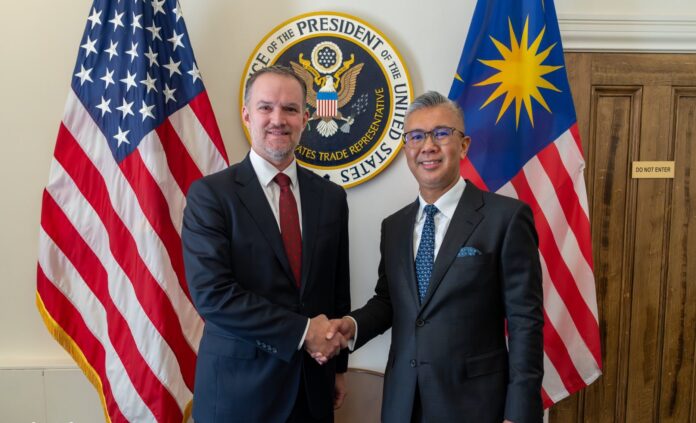- Malaysia received gets 19% tariff from the US after negotiations, with specifics undisclosed.
- Negotiations linked trade discussions to regional conflict resolution.
Malaysia has managed to secure a 19% tariff rate from the US, down from the initially threatened 25%, following negotiations that concluded with Prime Minister Anwar Ibrahim’s phone call with President Trump on July 31. The deal is said to have involved multiple components beyond traditional trade discussions, raising questions about whether the Malaysian approach represents a new model for regional engagement.
Multi-faceted negotiation strategy?
If Malaysia’s approach is proven true, it would differ from typical trade discussions by incorporating several non-traditional elements. According to The Straits Times‘ official sources, “the call was made earlier in the morning of July 31, after it was proposed by the Americans just a few hours back,” indicating last-minute urgency in the negotiations.
Potential factors in the negotiations may have included addressing US concerns about China’s market dominance. Sources suggest Malaysia could supply rare earth elements to the US, using the country’s deposits of more than 16 million tonnes worth an estimated RM1 trillion.
The would address Washington’s dependency concerns, given China’s current dominance in critical mineral production. Currently, rare earth ore mined in Malaysia is exported to China due to the country’s lack of domestic processing technology.
Malaysia may also recognise US halal certification for pharmaceuticals, representing a regulatory alignment opportunity. Malaysian trade officials told The Straits Times that “their certification is quite good” and the Malaysian Islamic Development Department has vetted the process, though no official arrangements have been confirmed.
Conflict resolution as a trade component
An unusual aspect of the tariff negotiations between Malaysia and the US involved regional conflict mediation. Anwar Ibrahim facilitated peace talks between Thailand and Cambodia on July 28, following Trump’s threat to halt tariff negotiations with both countries unless they resolved their two-month border conflict that resulted in multiple casualties.
Malaysia’s successful mediation resulted in a joint statement recognising the US as a “co-organiser” of the talks, with China as an “active participant” – a delicate diplomatic balance that satisfied all of the many stakeholders.
The innovative approach to linking regional stability with trade negotiations could become a template for other ASEAN nations seeking to enhance their value in US trade discussions.
Technology and policy boundaries
Malaysia’s approach appears to have balanced cooperation with maintaining policy independence. Since negotiations began, the country increased US gas purchases and tightened controls on “origin washing” and AI chip movement to address US concerns about Chinese sanctions evasion – measures that have been publicly confirmed.
However, Ibrahim maintained firm boundaries on domestic policies, specifically citing the Bumiputera policy as non-negotiable. The exemption of semiconductor exports from tariff coverage, 7.9% of Malaysia’s total exports, also protected a key technology sector.
Economic impact assessment
The US tariff outcome for Malaysia generated mixed reactions from analysts. UOB Kay Hian Wealth Advisors Sdn Bhd investment research head Mohd Sedek Jantan told Bernama (the Malaysian National News Agency)that “investor sentiment has also responded with relative composure” due to the lower-than-expected rate.
The tariff affects non-exempted goods, including furniture, rubber products, palm oil derivatives, and machines – sectors representing about 40% of Malaysia’s US$26 billion in US exports. Malaysia’s 19% rate compares to China’s 34% and Vietnam’s 20%.
Bank Muamalat Malaysia Bhd chief economist Dr Mohd Afzanizam Abdul Rashid also told Bernama that negative impacts may be “slightly mitigated” by policy frameworks outlined in Malaysia’s 13th Malaysia Plan, although trade tariffs typically show measurable GDP effects 12 to 15 months after implementation.
Regional context and questions
Trump’s confirmation of attendance at the October ASEAN Summit in Kuala Lumpur indicates continued US regional engagement, though the sustainability of this situation under in different administrations remains uncertain. Singapore Institute of International Affairs senior fellow Oh Ei Sun told The Straits Times that Trump recognises Southeast Asia as”one of the most dynamic regions of the world.”
The question for other Southeast Asian nations is whether Malaysia’s multi-component approach, if proven true – combining resource access, diplomatic mediation, and selective policy adjustments – represents a replicable model or reflects Malaysia’s unique circumstances and relationships.
The Ministry of Investment, Trade and Industry stated that the 19% rate was achieved through “a thorough and methodical negotiating process,” while Malaysia “stood firm on various ‘red line’ items,” specifics of which remain largely undisclosed.
Assessment and uncertainties
The tariff negotiations between Malaysia and the US illustrate evolving patterns in US-Southeast Asian trade relations, where traditional economic discussions increasingly incorporate broader strategic considerations, including resource security, technology cooperation, and regional stability.
However, several questions remain unanswered, particularly regarding what specific commitments were made beyond the tariff rate itself. The details of potential arrangements reported by The Straits Times – including rare earth supply agreements and halal certification recognition – have not been confirmed officially by either government.
It’s unclear whether this negotiation approach scales beyond Malaysia’s specific circumstances – including its non-aligned foreign policy positioning, strategic resource endowments, and Anwar’s diplomatic relationships. Other ASEAN nations may find different combinations of concessions and broader elements necessary, based on their particular economic profiles and political constraints.
The 19% tariff rate represents the confirmed near-term outcome, but the broader implications for technology transfer, supply chain resilience, and regional diplomatic dynamics will likely unfold over the coming years as both nations implement any commitments and navigate ongoing US-China competition in Southeast Asia.
(Image source: Photo by Minister of Investment, Trade & Industry Malaysia)
Want to learn more about cybersecurity and the cloud from industry leaders? Check out Cyber Security & Cloud Expo taking place in Amsterdam, California, and London.
Explore other upcoming enterprise technology events and webinars powered by TechForge here.

